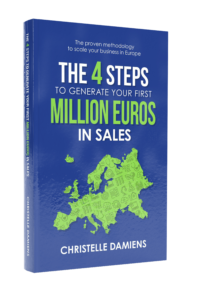7 Pillars to Help your Business Expand in the European Market
Since I founded Exportia in 2006, I have encountered hundreds of small businesses. With solid corporate experience and small business experience in export, I have noticed the same mistakes made by small and medium-sized businesses time and again. With the help of our 7 Pillars, this enables them to be more successful during their expansion in the European market.
While we have gone in-depth in previous blogs about the 7 Pillars, each pillar adapts depending on the level of your business. These pillars are:
- Product – when expanding in the European market, we recommend focusing first on your core products that have a proven track record. To learn more about choosing the right product. Read the full blog here.
- Customer – identifying your ideal customer profile will help you position your business in front of them. You can read the full blog here.
- Country – a focused approach is better when selecting the right country for your business. Focus on at least 1 country where your solution has the most potential. Check out our previous blog here for an in-depth explanation.
- Channels – also known as Distribution Channels or Channel Partners in the IT industry. We recommend focusing on 1 or 2 Sales Channels when expanding in the European market. You can read more about the importance of Sales Channels here.
- Marketing – we always recommend joining trade shows or digital congresses to help you boost your leads. You can check the full blog here to learn more.
- Team – keep your team engaged and motivated is the key to a successful expansion. Also, hiring Sales Agents helps in marketing your business in different regions. I talk about it more in-depth on this blog.
- Dashboard – this helps you manage your leads and monitor your overall progress while expanding in the European market. Read the full blog here.
Keeping the 7 Pillars in mind, here is additional information to help you understand each pillar and how they can help you expand your business in the European market while reducing your risks.
Positioning your Product
The first step is to focus on products that are likely to succeed in Europe. Then, focus on the compliance factor. Your product will not sell in Europe if it doesn’t conform to their standards and norms, period. Compliance is a must. If you want to sell in Europe, your product must conform to European standards. Whenever you meet with potential customers or partners, the first question they’ll ask you is: Do you adhere to European standards and norms?
For the Product Pillar, first, decide which products you will focus on at the beginning. Here’s a sample checklist to help you with your products:
- Are your products compliant with the European regulations to avoid any delay in selling them in the market?
- Are your products protected? Do you have an intellectual property protection strategy?
- Do you know your differentiators from competitors present in the European market?
- Do you have minimum order quantities (MOQ) per product?
- Do you have access to the estimated percentage of your typical order value to represent the cost of shipping and import duties?
- Have you established a multilingual European recommended retail price or list price?
- Have you formalised your multilingual distributor price list with a conservative margin?
You can have your copy for all the editable spreadsheets from our Resources Section.
Understand Your Ideal Customer
The success of your business in Europe depends on your prospects and customers. In particular, your first European customers should be your utmost priority. To identify your best potential clients, what I call the low-hanging fruit, you should first write a comprehensive profile about these clients. In working with clients, this is especially helpful, as we can ensure we are hitting the right targets.
Knowing your best customers well is the fastest way to enter the European market successfully. For example, you know from which industries they come and what problems they face. What’s most important is that you know how your solution or product is going to help them.
I will give you an example of how to effectively approach your potential European customers:
- Identify their pain points.
- Offer a valuable solution.
- Share your results.
Focus on the Right Country
It is critical that you choose the best European country for your product. Your best option is to go to a country with the greatest potential and the highest demand for your product or solution. The size of the market is not the only thing to consider; it is also the appetite for your product. Remember, you are trying to gain your first client quickly.
The German economy is huge and has tremendous potential, but the country is extremely risk-averse to adopting new technologies and unwilling to change. Can you hold out for so long?
By selecting the top European countries for products, we are mitigating this risk. Our goal is to choose the early adopters. As a result, you will be able to expand to other European countries. Our team at Exportia helps our customers in this process.
Partnering with the right Sales Channels
Sales channels buy and resell your software or products. The fastest, most cost-effective and least risky way to enter the European market is to establish good sales channels. To generate revenue, you don’t need to set up a subsidiary in Europe.
I have worked with many Australian small businesses involved in high-tech industries, such as medical devices, biotechnology, clean technologies, information and communications technology, and advanced manufacturing. Throughout this period, the challenge for small businesses was to generate high levels of sales from their distributors and, in our case, particularly our European distributors. To stop this debacle, I devised a simple 5-step solution.
- Profile – profiling your ideal distributor allows you to know if they are the right fit for your business goals and needs.
- Select – as soon as you establish your list of potential distributors, rate them against the selection criteria you created in your ideal distributor profile.
- Engage – before working with the selected distributor, make sure that both of you have a mutual agreement with the terms and payment.
- Activate – provide enough training materials for them to utilise in marketing your product.
- Manage – monitor their progress and schedule regular performance reviews.
Prepare your Marketing
Investing in Europe must lead to increased sales. Considering our clients are small businesses, we like to concentrate on marketing activities and tools that help us get into the market, generate leads, prove our credentials, and help raise our clients’ profiles. When introducing a new product or technology in the European market, we need to capture the attention of the target group quickly. If you use Trade Shows and Digital congresses to promote your business you will need to have the right messages and collateral to get traction.
For you to do that, here are a few things you can start in marketing your business in the European market:
- Provide your company profile.
- Design a professional product brochure.
- Share your company’s case study.
Keep your Teams Involved
The owner, who acts as the bottleneck, runs most small businesses. There are a couple of things to watch when you have a small team. Since business owners have limited time, it is important to ensure that European customers receive the attention they deserve. In being responsive and delivering on your promises, you need to build trust with them from the beginning. Export is a mission-critical element of the business, and everyone needs to be involved!
A great way of generating extra support is by establishing a network of sales agents. I recommend that you check with your distributors or channel partners if they are aware of any sales agents, and what they think about them. This can also avoid the common mistake many small businesses make in Europe in hiring too soon. When you hire too early, mostly this will result in a:
- Slow start in Europe
- Lack of knowledge in the market
- Hiring the wrong person
- Poor performance
Exportia’s services are hard to compare with a scenario where a small business recruits on its own for several reasons. We typically work together on every project. We generate leads, provide support to customers, and conduct sales and business development.
The Power of Dashboards
Dashboards have many advantages, and we love them at Exportia. Our clients must be able to see not only how their sales are tracking but also how their finances are doing. To succeed in the European market, SMEs must have a clear vision of the investment they need to support their export efforts. The amount of investment needs to be made over five years, or a minimum three-year period.
In the early stages of entering the European market, it may be difficult to track the progress of your sales team. Depending on the stage of your expansion, key performance indicators (KPIs) must be adjusted. There might be a lack of opportunities, or you might just need your team to develop a pipeline of prospects. Here are some KPIs to monitor:
- Concentrating on the right clients.
- Tracking early victories.
- Monitor the number of new distributors.
- Prepare reports on sales results and forecasts.
 Depending on where you are in your business, whether you are a start-up company or an established exporter, or whether you are new in Europe or a seasoned exporter, you will need to focus on each of the 7 Pillars.
Depending on where you are in your business, whether you are a start-up company or an established exporter, or whether you are new in Europe or a seasoned exporter, you will need to focus on each of the 7 Pillars.
Want to know more about how to succeed in Europe with the right product? Get your FREE copy of “The 4 Steps to Generate Your First Million Euros in Sales” book here. : https://www.exportia.com.au/export-business-europe/



